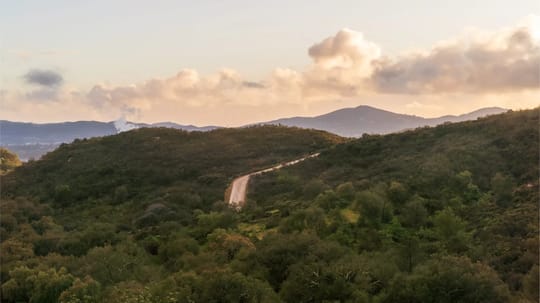As a monk, I’ve built numerous trails at Deer Park Monastery in Escondido, California, and each one has been a revelation. Each one teaches me something new about the difficulties and joys of the spiritual path. In many ways, the spiritual path is not a metaphor. It can be the physical path we walk—whether a new path we clear in the chaparral, a trail we traverse in the forest, or the mindful steps we take on concrete. The path is liberative because of the nature of our steps.
Trail building can be a mindful art. The Buddha himself was a trailblazer, opening an ancient path he called the Dharma. As a young boy, I distinctly remember building my first trail, something I could do on the largely wild, forested hillside our house perched upon. When I was about twelve, my father dedicated the whole week of my spring break to the project of building a tree house at the bottom of the hill in our Connecticut backyard together. We recycled wood from our old dock to use for siding and bolted two beams across the cleared surface of two pine trunks. An old window from our house’s construction decades before provided a view of the lake below—a lake created by a dam on the Housatonic River in the aftermath of the 1955 flood I mentioned above. My father designed an ingenious ladder that could be lowered via a pulley and rope going through the floor to become a staircase as part of the uphill wall of the tree house. When we finished, I spent one cold night out there—scary, but unforgettable.
To get straight down to the tree house from our house up the hill, I cleared a secret path that started right below a series of jagged rocks where my sister, cousin, and I used to pretend to crew the Battlestar Galactica. The path was steep, and I didn’t add any switchbacks, yet the skills I learned building it—clearing brush, eyeing the lay of the land for good footing, noticing which spaces (maybe where deer or coyote had travelled) invited passage—still inform my path building.
A core principle of path building is to do minimal harm. You don’t fight with the terrain; instead, you enter a profound flow state in which the path suggests itself. I do cut branches, move rocks, and sometimes extirpate a bush. This is painful for the plant and the living beings who depend on it. But I learn to mini- mize the harm, to back up frequently and rethink the trajectory of the path. Trail building, I’ve learned, is an intimate art of observation and implementation. At every moment, you must stop, reassess, adapt a new plan, and then act. Can I leave that bush intact? Are there many other plants of that type, and will it sprout up again easily in this ecosystem? Some places speak to you, saying: Don't touch. I can’t explain this process entirely. You see a large, green scorpion, or notice that a rattlesnake makes an area its lair, and you know to leave it alone. Poison oak? You can pull it out at the root, but beware. It may come back to haunt you. At Deer Park Monastery, poison oak is a native plant. Who am I to wage war against it?
When you become skilled in the art of path building, most of what you clear away will be dead matter. You learn to observe the landscape in your mind to know where the best footing is. You know when to go around, when to find another way, and when to continue straight ahead. Walking established paths, as we did most of the time during our seven weeks on the Appalachian Trail, connects you with those who have come before and created the path. There is love in a trail.
All this holds true for the spiritual path. I’ve certainly made mistakes and done harm without realizing it. But trail building taught me: stop before you inflict a wound carelessly—by word or deed—and back up. Look around, see if there’s another way. Remember the path is the destination—the experience is the walking, and by walking you build the path. Walk mindfully, and others will enjoy their own steps on the path you contribute to. Focus on the experience of building the path. When the building and the walking become one, you integrate the spiritual path, the path of the mind, and the path you walk on: mind and body unite. There’s only the path and the walking—no path maker, no walker. We already are what we want to become. The path reveals itself with each step.
This is an excerpt from Hiking Zen: Train Your Mind in Nature by Brother Pháp Xả and Brother Pháp Lưu, released May 2025 and published by Parallax Press.







